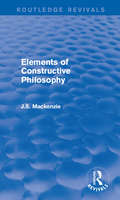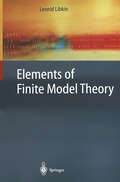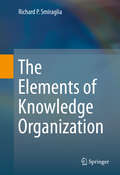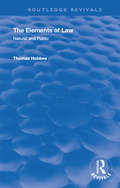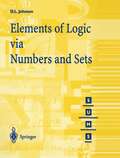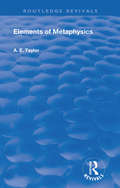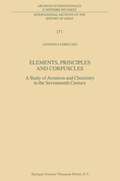- Table View
- List View
Elements of a Critical Theory of Justice
by Gustavo PereiraThe capacity to take part in dialogues and justify one's positions constitutes the normative core of critical social justice. Ensuring this capacity to every citizen is the main objective of justice, which requires transforming social structures and relations as well as counteracting the effects of capitalist dynamics.
Elements of a Philosophy of Management and Organization (Ethical Economy)
by Peter KoslowskiManaging as a form of human action has an inherent link with philosophy, which is also concerned with choosing the right action and the best way to lead our lives. Management theory and philosophy can join forces in epistemology (the philosophy of knowledge), ethics, and cultural theory. The epistemology of management concerns the question of how management can improve its ability to create knowledge about managing companies and about using management theory in the task of managing. Management ethics investigates the question of what the right management actions are. The cultural theory of management examines how corporate culture can increase the cooperation within the firm and how the cultural surplus value of products and brand management can increase the firm’s value creation in its products. This book introduces the readers to central approaches in this new field, which represents a synthesis of management and philosophical theory.
The Elements of Advanced Mathematics (Textbooks in Mathematics)
by Steven G. KrantzThis book has enjoyed considerable use and appreciation during its first four editions. With hundreds of students having learned out of early editions, the author continues to find ways to modernize and maintain a unique presentation. What sets the book apart is the excellent writing style, exposition, and unique and thorough sets of exercises. This edition offers a more instructive preface to assist instructors on developing the course they prefer. The prerequisites are more explicit and provide a roadmap for the course. Sample syllabi are included. As would be expected in a fifth edition, the overall content and structure of the book are sound. This new edition offers a more organized treatment of axiomatics. Throughout the book, there is a more careful and detailed treatment of the axioms of set theory. The rules of inference are more carefully elucidated. Additional new features include: An emphasis on the art of proof. Enhanced number theory chapter presents some easily accessible but still-unsolved problems. These include the Goldbach conjecture, the twin prime conjecture, and so forth. The discussion of equivalence relations is revised to present reflexivity, symmetry, and transitivity before we define equivalence relations. The discussion of the RSA cryptosystem in Chapter 8 is expanded. The author introduces groups much earlier. Coverage of group theory, formerly in Chapter 11, has been moved up; this is an incisive example of an axiomatic theory. Recognizing new ideas, the author has enhanced the overall presentation to create a fifth edition of this classic and widely-used textbook.
The Elements of Advanced Mathematics (Textbooks in Mathematics)
by Steven G. KrantzThis book has enjoyed considerable use and appreciation during its first four editions. With hundreds of students having learned out of early editions, the author continues to find ways to modernize and maintain a unique presentation. What sets the book apart is the excellent writing style, exposition, and unique and thorough sets of exercises. This edition offers a more instructive preface to assist instructors on developing the course they prefer. The prerequisites are more explicit and provide a roadmap for the course. Sample syllabi are included. As would be expected in a fifth edition, the overall content and structure of the book are sound. This new edition offers a more organized treatment of axiomatics. Throughout the book, there is a more careful and detailed treatment of the axioms of set theory. The rules of inference are more carefully elucidated. Additional new features include: An emphasis on the art of proof. Enhanced number theory chapter presents some easily accessible but still-unsolved problems. These include the Goldbach conjecture, the twin prime conjecture, and so forth. The discussion of equivalence relations is revised to present reflexivity, symmetry, and transitivity before we define equivalence relations. The discussion of the RSA cryptosystem in Chapter 8 is expanded. The author introduces groups much earlier. Coverage of group theory, formerly in Chapter 11, has been moved up; this is an incisive example of an axiomatic theory. Recognizing new ideas, the author has enhanced the overall presentation to create a fifth edition of this classic and widely-used textbook.
The Elements of Cantor Sets: With Applications
by Robert W. VallinA systematic and integrated approach to Cantor Sets and their applications to various branches of mathematics The Elements of Cantor Sets: With Applications features a thorough introduction to Cantor Sets and applies these sets as a bridge between real analysis, probability, topology, and algebra. The author fills a gap in the current literature by providing an introductory and integrated perspective, thereby preparing readers for further study and building a deeper understanding of analysis, topology, set theory, number theory, and algebra. The Elements of Cantor Sets provides coverage of: Basic definitions and background theorems as well as comprehensive mathematical details A biography of Georg Ferdinand Ludwig Philipp Cantor, one of the most significant mathematicians of the last century Chapter coverage of fractals and self-similar sets, sums of Cantor Sets, the role of Cantor Sets in creating pathological functions, p-adic numbers, and several generalizations of Cantor Sets A wide spectrum of topics from measure theory to the Monty Hall Problem An ideal text for courses in real analysis, topology, algebra, and set theory for undergraduate and graduate-level courses within mathematics, computer science, engineering, and physics departments, The Elements of Cantor Sets is also appropriate as a useful reference for researchers and secondary mathematics education majors.
The Elements of Cantor Sets: With Applications
by Robert W. VallinA systematic and integrated approach to Cantor Sets and their applications to various branches of mathematics The Elements of Cantor Sets: With Applications features a thorough introduction to Cantor Sets and applies these sets as a bridge between real analysis, probability, topology, and algebra. The author fills a gap in the current literature by providing an introductory and integrated perspective, thereby preparing readers for further study and building a deeper understanding of analysis, topology, set theory, number theory, and algebra. The Elements of Cantor Sets provides coverage of: Basic definitions and background theorems as well as comprehensive mathematical details A biography of Georg Ferdinand Ludwig Philipp Cantor, one of the most significant mathematicians of the last century Chapter coverage of fractals and self-similar sets, sums of Cantor Sets, the role of Cantor Sets in creating pathological functions, p-adic numbers, and several generalizations of Cantor Sets A wide spectrum of topics from measure theory to the Monty Hall Problem An ideal text for courses in real analysis, topology, algebra, and set theory for undergraduate and graduate-level courses within mathematics, computer science, engineering, and physics departments, The Elements of Cantor Sets is also appropriate as a useful reference for researchers and secondary mathematics education majors.
Elements of Constructive Philosophy (Routledge Revivals)
by J.S. MackenzieJ.S. Mackenzie surveys Western philosophy from Socrates to the New Realists in an uncomplicated and approachable style. Originally published in 1917, this text serves as a useful introduction to philosophy and well-summarises the key theories of great philosophers throughout the centuries and their bearing on early twentieth-century thought. It is ideal for students of Philosophy, both for beginners and the more advanced.
Elements of Constructive Philosophy (Routledge Revivals)
by J.S. MackenzieJ.S. Mackenzie surveys Western philosophy from Socrates to the New Realists in an uncomplicated and approachable style. Originally published in 1917, this text serves as a useful introduction to philosophy and well-summarises the key theories of great philosophers throughout the centuries and their bearing on early twentieth-century thought. It is ideal for students of Philosophy, both for beginners and the more advanced.
Elements of Finite Model Theory (Texts in Theoretical Computer Science. An EATCS Series)
by Leonid LibkinEmphasizes the computer science aspects of the subject. Details applications in databases, complexity theory, and formal languages, as well as other branches of computer science.
The Elements of Knowledge Organization
by Richard P. SmiragliaThe Elements of Knowledge Organization is a unique and original work introducing the fundamental concepts related to the field of Knowledge Organization (KO). There is no other book like it currently available. The author begins the book with a comprehensive discussion of “knowledge” and its associated theories. He then presents a thorough discussion of the philosophical underpinnings of knowledge organization. The author walks the reader through the Knowledge Organization domain expanding the core topics of ontologies, taxonomies, classification, metadata, thesauri and domain analysis. The author also presents the compelling challenges associated with the organization of knowledge. This is the first book focused on the concepts and theories associated with KO domain. Prior to this book, individuals wishing to study Knowledge Organization in its broadest sense would generally collocate their own resources, navigating the various methods and models and perhaps inadvertently excluding relevant materials. This text cohesively links key and related KO material and provides a deeper understanding of the domain in its broadest sense and with enough detail to truly investigate its many facets. This book will be useful to both graduate and undergraduate students in the computer science and information science domains both as a text and as a reference book. It will also be valuable to researchers and practitioners in the industry who are working on website development, database administration, data mining, data warehousing and data for search engines. The book is also beneficial to anyone interested in the concepts and theories associated with the organization of knowledge. Dr. Richard P. Smiraglia is a world-renowned author who is well published in the Knowledge Organization domain. Dr. Smiraglia is editor-in-chief of the journal Knowledge Organization, published by Ergon-Verlag of Würzburg. He is a professor and member of the Information Organization Research Group at the School of Information Studies at University of Wisconsin Milwaukee.
The Elements of Law: Natural and Politic (Routledge Revivals)
by Thomas HobbesOriginally published in 1889, Ferdinand Tonnies published versions of two works by Thomas Hobbes. His editions of The Elements of Law: Natural and Politic and of Behemoth: or The Long Parliament were the first modern critical editions, based on manuscripts of works by Hobbes. Completed in 1640, The Elements of Law was Hobbes's first systematic political work. The book helps us see Hobbes's mind at work, for it is the first version of his later political works.
The Elements of Law: Natural and Politic (Routledge Revivals)
by Thomas HobbesOriginally published in 1889, Ferdinand Tonnies published versions of two works by Thomas Hobbes. His editions of The Elements of Law: Natural and Politic and of Behemoth: or The Long Parliament were the first modern critical editions, based on manuscripts of works by Hobbes. Completed in 1640, The Elements of Law was Hobbes's first systematic political work. The book helps us see Hobbes's mind at work, for it is the first version of his later political works.
Elements of Logic via Numbers and Sets (Springer Undergraduate Mathematics Series)
by D.L. JohnsonIn mathematics we are interested in why a particular formula is true. Intuition and statistical evidence are insufficient, so we need to construct a formal logical proof. The purpose of this book is to describe why such proofs are important, what they are made of, how to recognize valid ones, how to distinguish different kinds, and how to construct them. This book is written for 1st year students with no previous experience of formulating proofs. Dave Johnson has drawn from his considerable experience to provide a text that concentrates on the most important elements of the subject using clear, simple explanations that require no background knowledge of logic. It gives many useful examples and problems, many with fully-worked solutions at the end of the book. In addition to a comprehensive index, there is also a useful `Dramatis Personae` an index to the many symbols introduced in the text, most of which will be new to students and which will be used throughout their degree programme.
Elements of Mathematics: From Euclid to Gödel
by John StillwellElements of Mathematics takes readers on a fascinating tour that begins in elementary mathematics—but, as John Stillwell shows, this subject is not as elementary or straightforward as one might think. Not all topics that are part of today's elementary mathematics were always considered as such, and great mathematical advances and discoveries had to occur in order for certain subjects to become "elementary." Stillwell examines elementary mathematics from a distinctive twenty-first-century viewpoint and describes not only the beauty and scope of the discipline, but also its limits.From Gaussian integers to propositional logic, Stillwell delves into arithmetic, computation, algebra, geometry, calculus, combinatorics, probability, and logic. He discusses how each area ties into more advanced topics to build mathematics as a whole. Through a rich collection of basic principles, vivid examples, and interesting problems, Stillwell demonstrates that elementary mathematics becomes advanced with the intervention of infinity. Infinity has been observed throughout mathematical history, but the recent development of "reverse mathematics" confirms that infinity is essential for proving well-known theorems, and helps to determine the nature, contours, and borders of elementary mathematics.Elements of Mathematics gives readers, from high school students to professional mathematicians, the highlights of elementary mathematics and glimpses of the parts of math beyond its boundaries.
Elements of Mathematics: A Problem-Centered Approach to History and Foundations (Undergraduate Texts in Mathematics)
by Gabor TothThis textbook offers a rigorous presentation of mathematics before the advent of calculus. Fundamental concepts in algebra, geometry, and number theory are developed from the foundations of set theory along an elementary, inquiry-driven path. Thought-provoking examples and challenging problems inspired by mathematical contests motivate the theory, while frequent historical asides reveal the story of how the ideas were originally developed. Beginning with a thorough treatment of the natural numbers via Peano’s axioms, the opening chapters focus on establishing the natural, integral, rational, and real number systems. Plane geometry is introduced via Birkhoff’s axioms of metric geometry, and chapters on polynomials traverse arithmetical operations, roots, and factoring multivariate expressions. An elementary classification of conics is given, followed by an in-depth study of rational expressions. Exponential, logarithmic, and trigonometric functions complete the picture, driven by inequalities that compare them with polynomial and rational functions. Axioms and limits underpin the treatment throughout, offering not only powerful tools, but insights into non-trivial connections between topics. Elements of Mathematics is ideal for students seeking a deep and engaging mathematical challenge based on elementary tools. Whether enhancing the early undergraduate curriculum for high achievers, or constructing a reflective senior capstone, instructors will find ample material for enquiring mathematics majors. No formal prerequisites are assumed beyond high school algebra, making the book ideal for mathematics circles and competition preparation. Readers who are more advanced in their mathematical studies will appreciate the interleaving of ideas and illuminating historical details.
Elements of Metaphysics (Routledge Revivals)
by A. E TaylorFirst published in 1903, Taylor endeavours to provide a detailed study of metaphysic as a discipline. Opening with a brief history of metaphysics, the book explores topics including the problem of the metaphysician, the metaphysical method, subdivisions of metaphysics, ontology, reality, cosmology, rational psychology, morality, ethics and religion.
Elements of Metaphysics (Routledge Revivals)
by A. E TaylorFirst published in 1903, Taylor endeavours to provide a detailed study of metaphysic as a discipline. Opening with a brief history of metaphysics, the book explores topics including the problem of the metaphysician, the metaphysical method, subdivisions of metaphysics, ontology, reality, cosmology, rational psychology, morality, ethics and religion.
The Elements of Moral Philosophy 7e (UK Higher Education Humanities & Social Sciences Philosophy)
by James Rachels Stuart RachelsFirmly established as the standard text for undergraduate courses in ethics, James Rachels and Stuart Rachels’ The Elements of Moral Philosophy introduces readers to major moral concepts and theories through eloquent explanations and compelling, thought-provoking discussions.
Elements Of The Philosophy Of Right (Cambridge Texts In The History Of Political Thought Series (PDF))
by Georg Wilhelm Friedrich Hegel Allen W. Wood H. B. Nisbet Raymond Geuss Quentin SkinnerThis book is a translation of a classic work of modern social and political thought, Elements of the Philosophy of Right. Hegel's last major published work, is an attempt to systematize ethical theory, natural right, the philosophy of law, political theory and the sociology of the modern state into the framework of Hegel's philosophy of history. Hegel's work has been interpreted in radically different ways, influencing many political movements from far right to far left, and is widely perceived as central to the communication tradition in modern ethical, social and political thought. This edition includes extensive editorial material informing the reader of the historical background of Hegel's text, and explaining his allusions to Roman law and other sources, making use of lecture materials which have only recently become available. The new translation is literal, readable and consistent, and will be informative and scholarly enough to serve the needs of students and specialists alike.
Elements of Responsible Politics (Contributions to Phenomenology #7)
by B.P. DauenhauerThis collection of essays draws together work done during a period of more than fifteen years. In the course of these years much has changed, including much about politics. Patterns of political activity have been trans formed. Ways in which we had been accustomed to construe politics have been substantially modified and sometimes replaced. Some apparently in tractable conflicts have been resolved. Other, apparently more manageable, conflicts have shown shocking durability. A number of political doctrines once considered indefinitely serviceable have lost all relevance. And the material and technical resources at our disposal look strikingly different than they did just a few years ago. Practical politics of whatever stripe encounters at every turn ever more grave environmental degradation. But, or so this collection assumes, not everything political has changed. Some political issues, both "theoretical" and "practical," remain persistently trenchant. Questions like the following demand ever renewed consideration. What is the point and worth of belonging to a political community? What entitlements and responsibilities follow upon such membership? Or even more fundamentally, what conditions are required for there to be politics at all? Taken together, the essays collected in this volume propose a way both to understand and to engage in politics which is properly responsive both to perennial political issues and to the peculiar exigencies of our era. Some of them present criticisms of widely held, warmly cherished ways of addressing political matters. Others propose constructive alternatives.
Elements of Social and Political Philosophy (Melbourne International Philosophy Series #2)
by Jan J.T. SrzednickiThe general purpose of this book differs from those of most of the works found traditionally in the field of political philosophy. Firstly, the present approach is in no way prescriptive or normative, as the interest centres on explication rather than an evaluative assess ment of this, that or another type of arrangement, or act. 1 It will be clear that I am in complete disagreement with Gewirth when he claims that "The central concern of political philosophy is the moral evaluation of political power. " It seems obvious that the under standing of political and social forms of life, and a fortiori of political power, must come before its evaluation. This cannot be provided by moral assessment alone. Thus an analytical or explicative approach which promotes such understanding must come first, and must be the "central concern" of the appropriate philosophical discipline. This is not to say that moral assessment is illegitimate, nor even that it cannot be one of the concerns of political philosophy, but it is to deny that it can be central, even though it might be somebody's central interest. To the extent to which this book is successful it will provide an argu mentin my favour - if the job can be done, obviously it is of primary importance. But we should not assume that it cannot be done unless we can show that there is no separate sphere of political and/or social phenomena.
Elements, Principles and Corpuscles: A Study of Atomism and Chemistry in the Seventeenth Century (International Archives of the History of Ideas Archives internationales d'histoire des idées #171)
by Antonio ClericuzioIn Elements, Principles and Particles, Antonio Clericuzio explores the relationships between chemistry and corpuscular philosophy in the age of the Scientific Revolution. Science historians have regarded chemistry and corpuscular philosophy as two distinct traditions. Clericuzio's view is that since the beginning of the 17th century atomism and chemistry were strictly connected. This is attested by Daniel Sennert and by many hitherto little-known French and English natural philosophers. They often combined a corpuscular theory of matter with Paracelsian chemical (and medical) doctrines. Boyle plays a central part in the present book: Clericuzio redefines Boyle's chemical views, by showing that Boyle did not subordinate chemistry to the principles of mechanical philosophy. When Boyle explained chemical phenomena, he had recourse to corpuscles endowed with chemical, not mechanical, properties. The combination of chemistry and corpuscular philosophy was adopted by a number of chemists active in the last decades of the 17th century, both in England and on the Continent. Using a large number of primary sources, the author challenges the standard view of the corpuscular theory of matter as identical with the mechanical philosophy. He points out that different versions of the corpuscular philosophy flourished in the 17th century. Most of them were not based on the mechanical theory, i.e. on the view that matter is inert and has only mechanical properties. Throughout the 17th century, active principles, as well as chemical properties, are attributed to corpuscles. Given its broad coverage, the book is a significant contribution to both history of science and history of philosophy.
The Elements We Live By: How Iron Helps Us Breathe, Potassium Lets Us See, and Other Surprising Superpowers of the Periodic Table
by Anja RøyneWinner of the 2018 Brage Prize'Perfect popular science . . . not just a well-written story about the elements, but a book about being human in the world today'Åsmund H. Eikenes, author of Splash: A History of Our BodiesWe all know that we depend on elements for survival - from oxygen in the air we breathe to carbon in the molecular structures of all living things. But we seldom appreciate how, say, phosphorus holds our DNA together or how potassium powers our optic nerves enabling us to see.Physicist and award-winning author Anja Røyne takes us on an astonishing journey through chemistry and physics, introducing the building blocks from which we humans - and everything else in the world - are made. Not only does Røyne explain why our bodies need iron, phosphorus, silicon, potassium and many more elements in just the right amounts in order to function, she also shows us where in the world these precious elements are found (some of them in limited and quickly depleting quantities).Røyne helps us understand how precariously balanced our lives - and ways of living - really are, and to appreciate little known and generally unsung heroes of the periodic table in an entirely new light.
The Elephant in the Room: Silence and Denial in Everyday Life
by Eviatar ZerubavelThe fable of the Emperor's New Clothes is a classic example of a conspiracy of silence, a situation where everyone refuses to acknowledge an obvious truth. But the denial of social realities--whether incest, alcoholism, corruption, or even genocide-is no fairy tale. In The Elephant in the Room, Eviatar Zerubavel sheds new light on the social and political underpinnings of silence and denial-the keeping of "open secrets." The author shows that conspiracies of silence exist at every level of society, ranging from small groups to large corporations, from personal friendships to politics. Zerubavel shows how such conspiracies evolve, illuminating the social pressures that cause people to deny what is right before their eyes. We see how each conspirator's denial is symbiotically complemented by the others', and we learn that silence is usually more intense when there are more people conspiring-and especially when there are significant power differences among them. He concludes by showing that the longer we ignore "elephants," the larger they loom in our minds, as each avoidance triggers an even greater spiral of denial. Drawing on examples from newspapers and comedy shows to novels, children's stories, and film, the book travels back and forth across different levels of social life, and from everyday moments to large-scale historical events. At its core, The Elephant in the Room helps us understand why we ignore truths that are known to all of us.
The Elephant in the Room: Silence and Denial in Everyday Life
by Eviatar ZerubavelThe fable of the Emperor's New Clothes is a classic example of a conspiracy of silence, a situation where everyone refuses to acknowledge an obvious truth. But the denial of social realities--whether incest, alcoholism, corruption, or even genocide-is no fairy tale. In The Elephant in the Room, Eviatar Zerubavel sheds new light on the social and political underpinnings of silence and denial-the keeping of "open secrets." The author shows that conspiracies of silence exist at every level of society, ranging from small groups to large corporations, from personal friendships to politics. Zerubavel shows how such conspiracies evolve, illuminating the social pressures that cause people to deny what is right before their eyes. We see how each conspirator's denial is symbiotically complemented by the others', and we learn that silence is usually more intense when there are more people conspiring-and especially when there are significant power differences among them. He concludes by showing that the longer we ignore "elephants," the larger they loom in our minds, as each avoidance triggers an even greater spiral of denial. Drawing on examples from newspapers and comedy shows to novels, children's stories, and film, the book travels back and forth across different levels of social life, and from everyday moments to large-scale historical events. At its core, The Elephant in the Room helps us understand why we ignore truths that are known to all of us.




